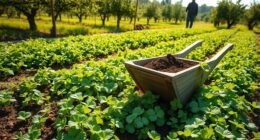To build a root cellar, select a shaded, underground spot for natural insulation, using stone, concrete, or cinder blocks to keep temperatures stable between 32°F and 40°F. Seal the entrance tightly and use ventilation to control humidity and airflow. Organize stored produce with breathable containers to prevent mold and rot. Regularly check temperature and humidity, and make adjustments as needed. Keep going to learn more tips for creating an effective, long-lasting storage space.
Key Takeaways
- Choose a shaded, underground location and build with stone, concrete, or cinder blocks for natural insulation.
- Maintain a consistent temperature between 32°F and 40°F using earth’s insulation and adjustable vents.
- Control moisture with absorbent materials and proper ventilation to prevent mold and rot.
- Organize produce with shelves or containers that promote air circulation and prevent cross-contamination.
- Regularly monitor temperature and humidity, and ensure seals and insulation are intact for optimal storage conditions.

Building a root cellar is a practical way to store vegetables and preserve your harvest naturally. When designing your cellar, focusing on effective temperature control and moisture management is essential. These factors keep your stored produce fresh longer and prevent spoilage. A well-constructed root cellar maintains a consistent, cool temperature—ideally between 32 and 40 degrees Fahrenheit—without fluctuations that can cause produce to rot or sprout. To achieve this, you can choose a shaded, underground location, as earth naturally insulates and stabilizes temperature. You might also consider adding insulation around the cellar walls or installing a ventilation system to help regulate airflow and temperature, especially during seasonal changes. Automation technologies can also assist in monitoring and maintaining optimal conditions automatically.
A well-built root cellar maintains 32–40°F, using insulation and ventilation to keep produce fresh year-round.
Moisture management is equally crucial. Too much moisture leads to mold, rot, and decay, while too little causes produce to dry out and shrivel. To strike the right balance, you should incorporate materials that regulate humidity, such as sand or sawdust, which absorb excess moisture and release it gradually. Ventilation plays a key role here, too, allowing moist air to escape and preventing dampness from accumulating. Installing adjustable vents or small windows helps you control airflow, especially during humid or dry spells. Additionally, lining shelves or bins with breathable materials like burlap or wire mesh encourages air circulation around your stored vegetables, reducing the risk of mold growth and maintaining optimal moisture levels.
As you build your root cellar, pay attention to the construction materials. Using stone, concrete, or cinder blocks helps insulate the space and maintain stable temperatures. Avoid materials that retain moisture or emit fumes that could compromise your stored produce. When organizing your cellar, group vegetables according to their storage needs, and use dividers or separate compartments if necessary to prevent cross-contamination. Also, ensure the entrance is well-sealed to prevent warm air from entering and disrupting your carefully maintained environment. Proper sealing, combined with insulation and ventilation, creates an ideal climate for your vegetables.
Regular monitoring is vital once your root cellar is operational. Check the temperature with a reliable thermometer and keep an eye on humidity levels, adjusting vents or adding moisture-absorbing materials as needed. If you notice condensation or dryness, make small tweaks to your ventilation or moisture management strategies. By paying close attention to these factors, you’ll extend the freshness of your harvest and enjoy your stored vegetables well into the winter months. Building a root cellar tailored to your climate and needs offers a sustainable, cost-effective way to preserve food naturally, ensuring your harvest remains nutritious and delicious year-round.
Frequently Asked Questions
What Is the Ideal Soil Type for a Root Cellar?
You should choose soil with good soil composition, ideally sandy or clay loam, for your root cellar. These types provide excellent moisture control, preventing excess dampness that can spoil stored food. Avoid highly sandy or rocky soils that drain too quickly, and stay away from heavy clay that retains too much moisture. Proper soil selection guarantees stable temperatures and humidity, keeping your food fresh and protected.
How Deep Should the Cellar Be Underground?
Think of your root cellar as a cozy underground retreat. You should dig it about 8 to 10 feet deep, where natural insulation helps maintain steady temperatures. To keep things comfortable, incorporate ventilation strategies and temperature control techniques, like vent pipes or insulated doors, ensuring proper airflow and consistent conditions. This depth and design create an ideal environment, keeping your stored treasures fresh and secure for the long haul.
What Materials Are Best for Sealing the Cellar?
When sealing your root cellar, choose durable materials like thick plastic sheeting or waterproof membrane to act as moisture barriers. Make certain you also consider ventilation options, such as vent pipes or adjustable vents, to prevent stale air and excess humidity. Proper sealing with these materials keeps moisture out, maintains a stable temperature, and promotes good air circulation, helping your stored food stay fresh longer.
How Can I Regulate Humidity Inside the Cellar?
To regulate humidity inside your root cellar, you should install proper ventilation systems to guarantee air circulation and prevent excess moisture buildup. Additionally, use moisture barriers like plastic sheeting or waterproof paint on walls and floors to control humidity levels. Regularly monitor the humidity with a hygrometer, and adjust ventilation or add desiccants as needed. Keeping humidity stable helps preserve your stored food effectively.
What Safety Precautions Are Necessary During Construction?
Building a root cellar is like constructing a fortress for your food. You need to prioritize safety by wearing sturdy gloves and eye protection, avoiding sharp tools. Guarantee proper ventilation strategies to prevent mold and pest prevention measures like sealing cracks and using pest barriers. Keep the workspace dry and well-lit, and follow local building codes. These precautions safeguard you and your food, making your cellar a secure, long-lasting storehouse.
Conclusion
Now that you’ve built your root cellar, remember the wisdom of ancient civilizations who stored their harvests underground, like the Egyptians with their granaries. Your cellar becomes a modern-day sanctuary, preserving nature’s bounty just as the past did. With patience and care, you’re creating a hidden treasure trove, a place where food stays fresh and memories of self-sufficiency remain alive. Embrace this tradition, and let your root cellar be a timeless link to those who stored life’s essentials long ago.










